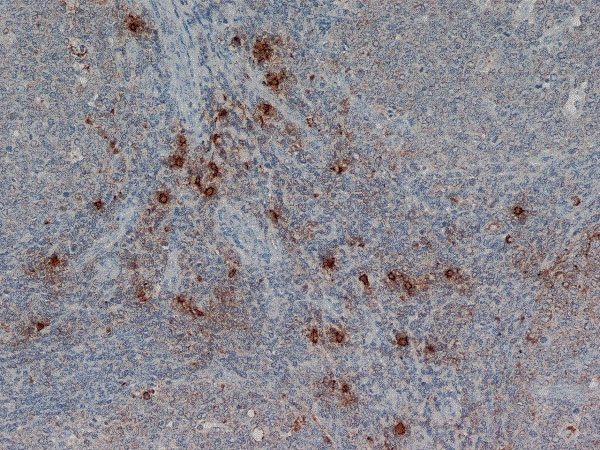Mast Cell Tryptase antibody | AA1

Mouse anti Human Mast Cell Tryptase
- Product Type
- Monoclonal Antibody
- Clone
- AA1
- Isotype
- IgG1
- Specificity
- Mast Cell Tryptase
| Mouse anti Human mast cell tryptase, clone AA1 recognizes human mast cell tryptase, both alpha and beta isoforms. Mouse anti Mast cell tryptase, clone AA1 is an excellent marker for mast cells, and does not bind to any other cell type in immunohistology (Walls et al. 1990). Tryptases are the products of a number of genes and form the major neutral protease present in mast cells secreted in response to infection and injury. Mast cell tryptase has an important role in the pathology of inflammatory diseases, especially asthma through bronchoconstriction (Zhang and Timmerman 1997). |
- Target Species
- Human
- Species Cross-Reactivity
-
Target Species Cross Reactivity Dog Monkey Cat Rat - N.B. Antibody reactivity and working conditions may vary between species.
- Product Form
- Purified IgG - liquid
- Preparation
- Purified IgG prepared by affinity chromatography on Protein A from tissue culture supernatant
- Buffer Solution
- Phosphate buffered saline
- Preservative Stabilisers
- 0.09% sodium azide (NaN3)
- Carrier Free
- Yes
- Immunogen
- Human mast cell tryptase purified from human lung tissue.
- Approx. Protein Concentrations
- IgG concentration 1.0 mg/ml
- Fusion Partners
- Spleen cells from immunised Balb/c mice were fused with cells of the mouse NS1 myeloma cell line.
- Regulatory
- For research purposes only
- Guarantee
- 12 months from date of despatch
Avoid repeated freezing and thawing as this may denature the antibody. Storage in frost-free freezers is not recommended.
| Application Name | Verified | Min Dilution | Max Dilution |
|---|---|---|---|
| ELISA | |||
| Immunofluorescence | |||
| Immunohistology - Frozen | |||
| Immunohistology - Paraffin 1 | 1/10,000 | ||
| Western Blotting |
- 1This product requires antigen retrieval using heat treatment prior to staining of paraffin sections.Sodium citrate buffer pH 6.0 is recommended for this purpose.
- Histology Positive Control Tissue
- Tonsil
Source Reference
-
Walls, A.F. et al. (1990) Production and characterization of monoclonal antibodies specific for human mast cell tryptase.
Clin Exp Allergy. 20 (5): 581-9.
References for Mast Cell Tryptase antibody
-
Walls, A.F. et al. (1990) Immunohistochemical identification of mast cells in formaldehyde-fixed tissue using monoclonal antibodies specific for tryptase.
J Pathol. 162 (2): 119-26. -
Ozaki, K. et al. (2002) Mast cell tumors of the gastrointestinal tract in 39 dogs.
Vet Pathol. 39 (5): 557-64. -
Thienemann, F. et al. (2004) Regulation of mast cell characteristics by cytokines: divergent effects of interleukin-4 on immature mast cell lines versus mature human skin mast cells.
Arch Dermatol Res. 296: 134-8. -
Jacob, C. et al. (2005) Mast cell tryptase controls paracellular permeability of the intestine. Role of protease-activated receptor 2 and beta-arrestins.
J Biol Chem. 280: 31936-48. -
Asano-Kato, N. et al. (2005) Tryptase increases proliferative activity of human conjunctival fibroblasts through protease-activated receptor-2.
Invest Ophthalmol Vis Sci. 46: 4622-6. -
Facoetti, A. et al. (2006) Histochemical study of cardiac mast cells degranulation and collagen deposition: interaction with the cathecolaminergic system in the rat.
Eur J Histochem. 50: 133-40. -
Mauro, L.V. et al. (2008) Association between mast cells of different phenotypes and angiogenesis in colorectal cancer.
Mol Med Report. 1: 895-902. -
Louiset, E. et al. (2008) Ectopic expression of serotonin7 receptors in an adrenocortical carcinoma co-secreting renin and cortisol.
Endocr Relat Cancer.15: 1025-34.
View The Latest Product References
-
Liu, J. et al. (2009) Genetic deficiency and pharmacological stabilization of mast cells reduce diet-induced obesity and diabetes in mice.
Nat Med. 15: 940-5. -
Kawarai, S. et al. (2010) Cultivation and characterization of canine skin-derived mast cells.
J Vet Med Sci. 72 (2): 131-40. -
Dichlberger, A. et al. (2011) Lipid body formation during maturation of human mast cells.
J Lipid Res. 52: 2198-208. -
Perbellini, O. et al. (2011) Primary role of multiparametric flow cytometry in the diagnostic work-up of indolent clonal mast cell disorders.
Cytometry B Clin Cytom. 80 (6): 362-8. -
Xiang, M. et al. (2011) Usefulness of serum tryptase level as an independent biomarker for coronary plaque instability in a Chinese population.
Atherosclerosis. 215 (2): 494-9. -
Kazama, I. et al. (2015) Mast cell involvement in the progression of peritoneal fibrosis in rats with chronic renal failure.
Nephrology (Carlton). 20 (9): 609-16. -
Luo, J. et al. (2016) An indispensable role of CPT-1a to survive cancer cells during energy stress through rewiring cancer metabolism.
Tumour Biol. Oct 13 [Epub ahead of print]. -
Kato, Y. et al. (2016) Cutaneous mastocytosis with a mutation in the juxtamembrane domain of c-kit in a young laboratory beagle dog.
J Toxicol Pathol. 29 (1): 49-52. -
Baba, A. et al. (2017) Less contribution of mast cells to the progression of renal fibrosis in Rat kidneys with chronic renal failure.
Nephrology (Carlton). 22 (2): 159-67.
- RRID
- AB_322318
- UniProt
- P20231
- Q15661
- Entrez Gene
- TPSB2
- TPSAB1
- GO Terms
- GO:0005515 protein binding
- GO:0004252 serine-type endopeptidase activity
- GO:0005576 extracellular region
- GO:0006508 proteolysis
Please Note: All Products are "FOR RESEARCH PURPOSES ONLY"
View all Anti-Human ProductsAlways be the first to know.
When we launch new products and resources to help you achieve more in the lab.
Yes, sign me up